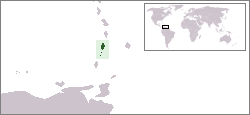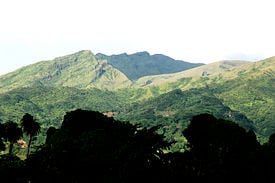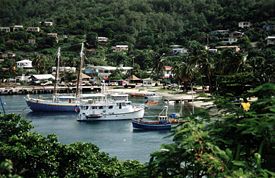Difference between revisions of "Saint Vincent and the Grenadines" - New World Encyclopedia
Mary Anglin (talk | contribs) |
({{Contracted}}) |
||
| Line 1: | Line 1: | ||
| − | {{claimed}} | + | {{claimed}}{{Contracted}} |
{{Infobox Country or territory | {{Infobox Country or territory | ||
|native_name = Saint Vincent and the Grenadines | |native_name = Saint Vincent and the Grenadines | ||
Revision as of 17:08, 31 October 2007
| Saint Vincent and the Grenadines | |||||
| |||||
| Motto: "Pax et justitia" (Latin) "Peace and justice" | |||||
| Anthem: St Vincent Land So Beautiful | |||||
| Capital | Kingstown 13°10′N 61°14′W | ||||
|---|---|---|---|---|---|
| Largest city | capital | ||||
| Official languages | English | ||||
| Government | Parliamentary democracy (constitutional monarchy) | ||||
| - Monarch | Queen Elizabeth II | ||||
| - Governor-General | Sir Frederick Ballantyne | ||||
| - Prime Minister | Ralph Gonsalves | ||||
| Independence | |||||
| - from the United Kingdom | 27 October 1979 | ||||
| Area | |||||
| - Total | 389 km² (201st) 150 sq mi | ||||
| - Water (%) | negligible | ||||
| Population | |||||
| - 2005 estimate | 119,000 | ||||
| - Density | 307/km² 792/sq mi | ||||
| GDP (PPP) | 2002 estimate | ||||
| - Total | $342 million | ||||
| - Per capita | $7,493 | ||||
| HDI (2004) | |||||
| Currency | East Caribbean dollar (XCD)
| ||||
| Internet TLD | .vc | ||||
| Calling code | +1-784 | ||||
Saint Vincent and the Grenadines is an island state in the Windward Islands of the Lesser Antilles, an island arc of the Caribbean Sea in North America. The country consists of the main island of Saint Vincent and the northern two-thirds of the Grenadines, a chain of small islands stretching south from Saint Vincent to Grenada. Its total land area is 389 km² of which 344 km² is the island of Saint Vincent. The country's capital is at Kingstown on Saint Vincent. The country has a British colonial history and is now part of the Commonwealth of Nations and CARICOM.
Geography
The main island of Saint Vincent and the Grenadines is Saint Vincent. Its geography is mostly volcanic and includes very little level ground. There is also a large difference between the coastlines on each side of the island. The windward side is very rocky, while the leeward side consists of many sandy beaches and has many more bays. The island's as well as the country's highest peak is the volcanic Soufrière at 1234 m. There are several tiny islets offshore of Saint Vincent including Young Island and the Cow And Calves Islands.
In addition to Saint Vincent, major islands in the Saint Vincent and the Grenadines are the northern Grenadines including (from north to south) the islands of :
- Bequia
- Petite Nevis
- Quatre
- Bettowia
- Baliceaux
- Mustique
- Petite Mustique
- Savan
- Petite Canouan
- Canouan
- Mayreau
- The Tobago Cays
- Union Island
- Petit Saint Vincent
- Palm Island
Saint Vincent and the Grenadines' Grenadines also include hundreds of smaller islets. The remainder of the Grenadines to the south are administered by Grenada.
Area and boundaries
Location: Caribbean, islands in the Caribbean Sea, north of Trinidad and Tobago
Geographic coordinates: 13°15′N 61°12′W
Map references: Central America and the Caribbean
Area:
total:
389 km² (Saint Vincent 344 km²)
land:
389 km²
water:
0 km²
Area - comparative: twice the size of Washington, D.C. in the United States
Land boundaries: 0 km
Coastline: 84 km
Maritime claims:
contiguous zone:
24 nautical miles (44 km)
continental shelf:
200 nautical miles (370 km)
exclusive economic zone:
200 nautical miles (370 km)
territorial sea:
12 nautical miles (22 km)
Climate: tropical; little seasonal temperature variation; rainy season (May to November)
Terrain: volcanic, mountainous
Elevation extremes:
lowest point:
Caribbean Sea 0 m
highest point:
Soufriere 1,234 m
Resources and land use
Natural resources: hydropower, cropland
Land use:
arable land:
10%
permanent crops:
18%
permanent pastures:
5%
forests and woodland:
36%
other:
31% (1993 est.)
Irrigated land: 10 km² (1993 est.)
Natural hazards: hurricanes; Soufrière (volcano) on the island of Saint Vincent is a constant threat
Environment - current issues: pollution of coastal waters and shorelines from discharges by pleasure yachts and other effluents; in some areas, pollution is severe enough to make swimming prohibitive
History
Carib Indians aggressively prevented European settlement on St. Vincent until the 18th century. Enslaved Africans — whether shipwrecked or escaped from Barbados, St. Lucia and Grenada and seeking refuge in mainland St. Vincent, or Hairouna as it was originally named by the Caribs — intermarried with the Caribs and became known as Garifuna or Black Caribs. Beginning in 1719, French settlers cultivated coffee, tobacco, indigo, cotton, and sugar on plantations worked by enslaved Africans. In 1763, St. Vincent was ceded to Britain. Restored to French rule in 1779, St. Vincent was regained by the British under the Treaty of Paris (1783) in which Great Britain officially recognized the end of the American Revolution. Ancillary treaties were also signed with France and Spain, known as the Treaties of Versailles of 1783, part of which put St. Vincent back under British control.
Conflict between the British and the Black Caribs, led by defiant Paramount Chief Joseph Chatoyer, continued until 1796, when General Sir Ralph Abercromby crushed a revolt fomented by the French radical Victor Hugues. More than 5,000 Black Caribs were eventually deported to Roatán, an island off the coast of Honduras.
Slavery was abolished in 1834. After the apprenticeship period, which ended prematurely in 1838, labour shortages on the plantations resulted in the immigration of indentured servants. The Portuguese came from Madeira starting in the 1840s and shiploads of East Indian labourers arrived between 1861-1880. Conditions remained harsh for both former slaves and immigrant agricultural workers, as depressed world sugar prices kept the economy stagnant until the turn of the century.
From 1763 until independence, St. Vincent passed through various stages of colonial status under the British. A representative assembly was authorized in 1776, Crown Colony government installed in 1877, a legislative council created in 1925, and universal adult suffrage granted in 1951.
During this period, the British made several unsuccessful attempts to affiliate St. Vincent with other Windward Islands in order to govern the region through a unified administration. The colonies themselves, desirous of freedom from British rule, made a notable attempt at unification called West Indies Federation, which collapsed in 1962. St. Vincent was granted associate statehood status on October 27th, 1969, giving it complete control over its internal affairs. Following a referendum in 1979, under Milton Cato St. Vincent and the Grenadines became the last of the Windward Islands to gain independence on the 10th anniversary of its associate statehood status, October 27th, 1979.
Natural disasters have featured in the country's history. In 1902, La Soufrière volcano erupted, killing 2,000 people. Much farmland was damaged, and the economy deteriorated. In April 1979, La Soufrière erupted again. Although no one was killed, thousands had to be evacuated, and there was extensive agricultural damage. In 1980 and 1987, hurricanes compromised banana and coconut plantations; 1998 and 1999 also saw very active hurricane seasons, with Hurricane Lenny in 1999 causing extensive damage to the west coast of the island.
See Treaty of Paris (1763)
Politics
Politics of Saint Vincent and the Grenadines takes place in the framework of an independent parliamentary democratic Commonwealth Realm with Queen Elizabeth II as its head of state, represented by a Governor General, who acts on the advice of the prime minister and the cabinet. The prime minister is the leader of the majority party of the house, and the cabinet conducts affairs of state. The Governor General exercises basically ceremonial functions, but residual powers, under the constitution, can be used at the Governor General's discretion.
The House of Assembly of Saint Vincent and the Grenadines is a unicameral parliament with fifteen elected members and six appointed senators. The governor general appoints senators, four on the advice of the prime minister and two on the advice of the leader of the opposition. The parliamentary term of office is five years, although the prime minister may call elections at any time.
As in other English-speaking Caribbean countries, the judiciary in St. Vincent is rooted in English common law. There are eleven courts in three magisterial districts. The Eastern Caribbean Supreme Court, comprising a high court and a court of appeals, is known in St. Vincent as the St. Vincent and the Grenadines supreme court. The court of last resort is the judicial committee of Her Majesty's Privy Council in London. Moves are currently being made to establish a Caribbean Court of Justice and replace the Privy Council as the country's highest court of appeal.
There is no local government in St. Vincent, and all six parishes are administered by the central government. The country has no formal armed forces, though Royal Saint Vincent and the Grenadines Police Force includes a Special Service Unit.
Saint Vincent and the Grenadines are a full & participating member of the Caribbean Community (CARICOM) and the Organisation of Eastern Caribbean States (OECS).
Administrative divisions
Administratively, Saint Vincent and the Grenadines is divided into six parishes, with five on Saint Vincent, and the Grenadines together comprising the sixth. Kingstown is located in the Parish of St. George and is the capital city and central administrative centre of the nation.
- Charlotte
- Grenadines
- Saint Andrew
- Saint David
- Saint George
- Saint Patrick
Foreign relations
Saint Vincent and the Grenadines maintains close ties to the U.S., Canada, and the United Kingdom, and cooperates with regional political and economic organizations such as the Organisation of Eastern Caribbean States (OECS) and CARICOM. St. Vincent and the Grenadines is a member of the United Nations, the Commonwealth of Nations, the Organization of American States, and the Association of Caribbean States (ACS).
As a member of CARICOM, St. Vincent and the Grenadines strongly backed efforts by the United States to implement UN Security Council Resolution 940, designed to facilitate the departure of Haiti's de facto authorities from power. The country agreed to contribute personnel to the multinational force, which restored the democratically elected government of Haiti in October 1994.
In May 1997, Prime Minister Mitchell joined 14 other Caribbean leaders and U.S. President Bill Clinton during the first-ever U.S.-regional summit in Bridgetown, Barbados. The summit strengthened the basis for regional cooperation on justice and counternarcotics issues, finance and development, and trade.
St. Vincent and the Grenadines maintains close relations with Cuba, which provides a number of scholarship and other exchange programs for Vincentians, particularly in the field of healthcare. It also has diplomatic relations with the Republic of China (Taiwan) instead of the People's Republic of China.
Saint Vincent protests Venezuela's claim to give full effect to Aves (Bird) Island, which creates a Venezuelan EEZ/continental shelf extending over a large portion of the Caribbean Sea.
Saint Vincent is a transshipment point for South American illicit drugs destined for the US and Europe.
Economy
Agriculture, dominated by banana production, is the most important sector of this lower-middle-income economy. The services sector, based mostly on a growing tourist industry, is also important. The government has been relatively unsuccessful at introducing new industries, and a high unemployment rate of 22% continues. The continuing dependence on a single crop represents the biggest obstacle to the islands' development; tropical storms wiped out substantial portions of crops in both 1994 and 1995. The tourism sector has considerable potential for development over the next decade. Recent growth has been stimulated by strong activity in the construction sector and an improvement in tourism. There is a small manufacturing sector and a small offshore financial sector whose particularly restrictive secrecy laws have caused some international concern. In addition the natives of Bequia are permitted to hunt up to 4 Humpback Whales per year under IWC subsistence quotas.
Demographics
Most Vincentians are the descendants of African slaves brought to the island to work on plantations. There also are a few white descendants of English colonists and Portuguese migrants, as well as some East Indians, Carib Indians, and a sizable minority of mixed race.
The country's official language is English. French Creole used to be more widely spoken, but now it has been declining to almost nothing on the island. St. Vincent has a high rate of emigration. With extremely high unemployment and under-employment, population growth remains a major problem.
ReferencesISBN links support NWE through referral fees
- Bobrow, Jill & Jinkins, Dana. 1985. St. Vincent and the Grenadines. 4th Edition Revised and Updated, Concepts Publishing Co., Waitsfield, Vermont, 1993.
- Gonsalves, Ralph E. 1994. History and the Future: A Caribbean Perspective. Quik-Print, Kingstown, St. Vincent.
- Williams, Eric. 1964. British Historians and the West Indies, Port-of-Spain.
- CIA Factbook entry
- US Dept of State Profile
External links
- St. Vincent Paper Money
- St Vincent and the Grenadines Genealogy Research
- Official website of the Government of St. Vincent and the Grenadines
- Official website of the SVG Indian Heritage Foundation
Credits
New World Encyclopedia writers and editors rewrote and completed the Wikipedia article in accordance with New World Encyclopedia standards. This article abides by terms of the Creative Commons CC-by-sa 3.0 License (CC-by-sa), which may be used and disseminated with proper attribution. Credit is due under the terms of this license that can reference both the New World Encyclopedia contributors and the selfless volunteer contributors of the Wikimedia Foundation. To cite this article click here for a list of acceptable citing formats.The history of earlier contributions by wikipedians is accessible to researchers here:
- Saint_Vincent_and_the_Grenadines history
- Geography_of_Saint_Vincent_and_the_Grenadines history
- Politics_of_Saint_Vincent_and_the_Grenadines history
- Foreign_relations_of_Saint_Vincent_and_the_Grenadines history
The history of this article since it was imported to New World Encyclopedia:
Note: Some restrictions may apply to use of individual images which are separately licensed.





